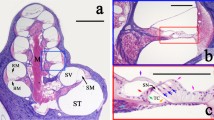Abstract
Decellularized tissues have been used to investigate the extracellular matrix (ECM) in a number of different tissues and species. Santi and Johnson JARO 14:3-15 (2013) first described the decellularized inner ear in the mouse, rat, and human using scanning thin-sheet laser imaging microscopy (sTSLIM). The purpose of the present investigation is to examine decellularized cochleas in the mouse and human at higher resolution using scanning electron microscopy (SEM). Fresh cochleas were harvested and decellularized using detergent extraction methods. Following decellularization, the ECM of the bone, basilar membrane, spiral limbus, and ligament remained, and all of the cells were removed from the cochlea. A number of similarities and differences in the ECM of the mouse and human were observed. A novel, spirally directed structure was present on the basilar membrane and is located at the border between Hensen and Boettcher cells. These septa-like structures formed a single row in the mouse and multiple rows in the human. The basal lamina of the stria vascularis capillaries was present and appeared thicker in the human compared with the mouse. In the mouse, numerous openings beneath the spiral prominence that previously housed the root processes of the external sulcus cells were observed but in the human there was only a single row of openings. These and other anatomical differences in the ECM between the mouse and human may reflect functional differences and/or be due to aging; however, decellularized cochleas provide a new way to examine the cochlear ECM and reveal new observations.
















Similar content being viewed by others
References
Cosgrove D, Samuelson G, Meehan DT, Miller C, McGee J, Walsh EJ, Siegel M (1998) Ultrastructural, physiological, and molecular defects in the inner ear of a gene-knockout mouse model for autosomal Alport syndrome. Hear Res 121:84–98
Duvall A, Flock A, Wersall J (1966) The ultrastructure of the sensory hairs and associate organelles of the cochlear inner hair cells, with reference to directional sensitivity. J Cell Bio 24:497–505
Engstrom H (1951) Microscopic anatomy of the inner ear. Acta Otolaryng 40:522
Friedmann I (1962) The cytology of the ear. Brit Med Bull 18:209–213
Iurato S (1967) Submicroscopic structure of the inner ear. Pergamon Press, London
Jagger DJ, Forge A (2013) The enigmatic root cell—emerging roles contributing to fluid homeostasis within the cochlear outer sulcus. Hear Res 303:1–11
Kanazawa A, Sunami K, Takayama M, Nishiura H, Tokuhara Y, Sakamoto H, Iguchi H, Yamane H (2004) Probable function of Boettcher cells based on results of morphological study: localization of nitric oxide synthase. Acta Otolaryngol Suppl 554:12–6
Kleppel MM, Santi PA, Cameron JD, Wieslander J, Michael AF (1989a) Human tissue distribution of novel basement membrane collagen. Am J Pathol 134:813–825
Kleppel MM, Kashtan C, Santi PA, Wieslander J, Michael AF (1989b) Distribution of familial nephritis antigen in normal tissue and renal basement membranes of patients with homozygous and heterozygous Alport familial nephritis. Relationship of familial nephritis and Goodpasture antigens to novel collagen chains and type IV collagen. Lab Invest 61:278–289
Lim DJ (1969) Three dimensional observation of the inner ear with the scanning electron microscope. Acta Otolaryng Suppl 255
Lim DJ (1970) Morphology and function of the interdental cell an ultrastructural observation. J Laryngology Otology 84:1241–1256
Liu W, Atturo F, Aldaya R, Santi P, Cureoglu S, Obwegeser S, Glueckert R, Pfaller K, Schrott-Fischer A, Rask-Andersen H (2015) Macromolecular organization and fine structure of the human basilar membrane—RELEVANCE for cochlear implantation. Cell Tissue Res 360:245–262
Mammano F, Ashmore JF (1993) Reverse transduction measured in the isolated cochlea by laser Michelson interferometry. Nature 365:838–841
Nobili R, Mammano F, Ashmore J (1998) How well do we understand the cochlea? TINS 21:159–166
Santi PA (1988) Cochlear microanatomy and ultrastructure. In: Physiology of the Ear, Eds., AF Jahn and FR Santos-Sacchi. Raven, New York, pp 173–199
Santi PA, Johnson SB (2013) Decellularized ear tissues as scaffolds for stem cell differentiation. JARO 14:3–15
Santi PA, Larson JT, Furcht LT, Economou TS (1989) Immunohistochemical localization of fibronectin in the chinchilla cochlea. Hear Res 39:91–101
Seligman AM, Wasserkrug HL, Hanker JS (1966) A new staining method (OTO) for enhancing contrast of lipid-containing membranes and droplets in osmium tetroxide-fixed tissue with osmiophilic thiocarbohydrazide (TCH). J Cell Biol 30:424–432
Smith CA, Sjoestrand FS (1961) Structure of the nerve endings on the external hair cells of the guinea pig cochlea as studied by serial section. J Ultrastruc Res 5:523–556
Swartz DJ, Santi PA (1999) Immunolocalization of tenascin in the chinchilla inner ear. Hear Res 130:108–14
Tsuprun V, Santi PA (1999) Ultrastructure and immunohistochemical identification of the extracellular matrix of the chinchilla cochlea. Hear Res 129:35–49
Tsuprun V, Santi PA (2001) Proteoglycan arrays in the cochlear basement membrane. Hear Res 157:65–76
Acknowledgments
The authors would like to thank Meredith Adams, M.D., for perfusing one of the human cochleas with SDS. Funding was provided to PAS by the NIDCD (RO1DC007588, U24DC011968), the Capita Foundation, and the Lions Hearing Foundation. The authors would like to thank Gail Celio at the University Imaging Centers for excellent assistance with SEM. Additional funding was supported by research of the European Community Research, Human stem cell applications for the treatment of hearing loss. Grant agreement no. 603029. Project acronym: OTOSTEM (HRA).
Author information
Authors and Affiliations
Corresponding author
Rights and permissions
About this article
Cite this article
Santi, P.A., Aldaya, R., Brown, A. et al. Scanning Electron Microscopic Examination of the Extracellular Matrix in the Decellularized Mouse and Human Cochlea. JARO 17, 159–171 (2016). https://doi.org/10.1007/s10162-016-0562-z
Received:
Accepted:
Published:
Issue Date:
DOI: https://doi.org/10.1007/s10162-016-0562-z




